sensor LEXUS NX300h 2015 Service Manual
[x] Cancel search | Manufacturer: LEXUS, Model Year: 2015, Model line: NX300h, Model: LEXUS NX300h 2015Pages: 681, PDF Size: 9.14 MB
Page 310 of 681
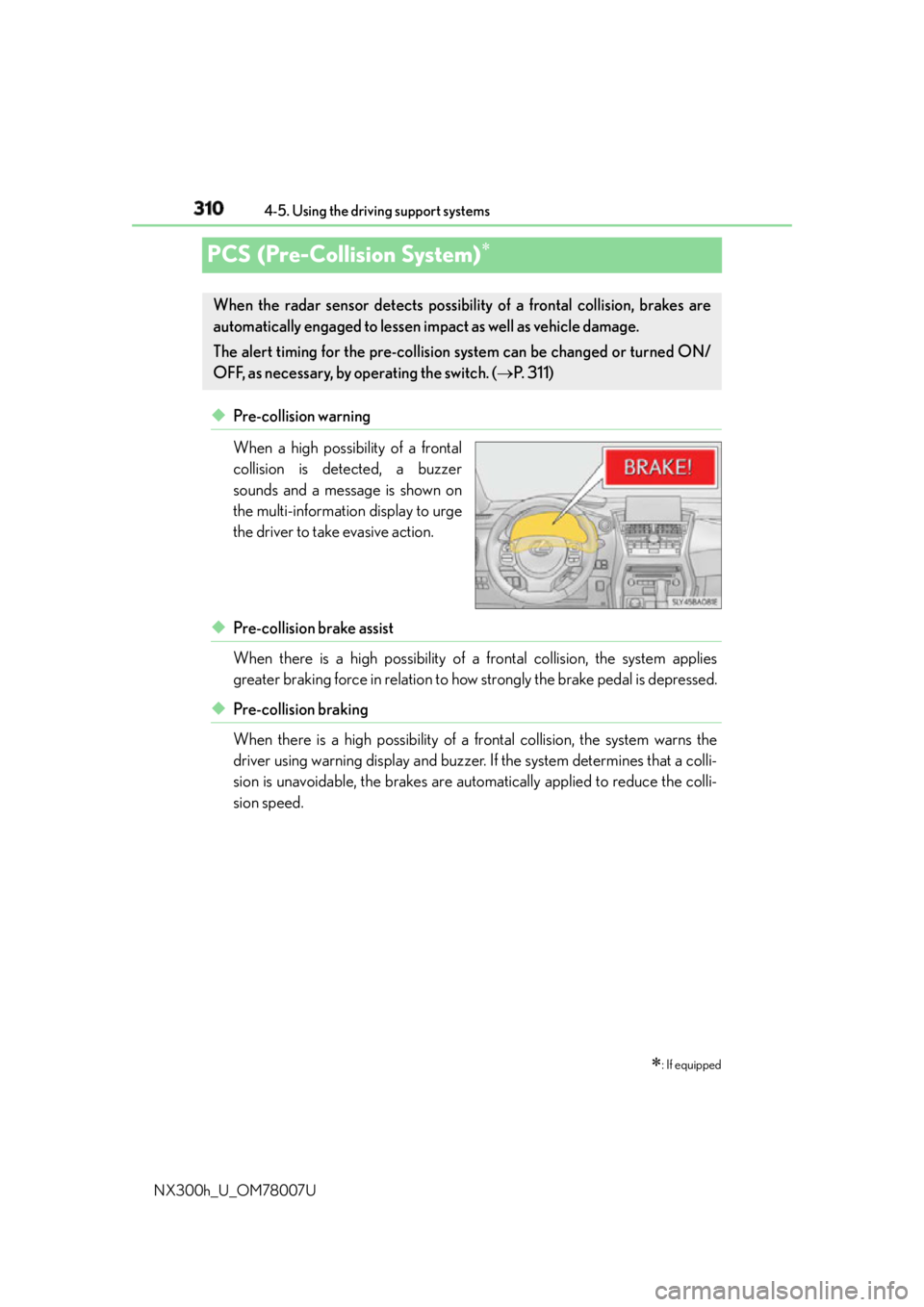
310 4-5. Using the driving support systems
NX300h_U_OM78007UPCS (Pre-Collision System)
◆ Pre-collision warning
When a high possibility of a frontal
collision is detected, a buzzer
sounds and a message is shown on
the multi-information display to urge
the driver to take evasive action.
◆ Pre-collision brake assist
When there is a high possibility of a frontal collision, the system applies
greater braking force in relation to ho w strongly the brake pedal is depressed.
◆ Pre-collision braking
When there is a high possibility of a frontal collision, the system warns the
driver using warning display and buzzer. If the system determines that a colli-
sion is unavoidable, the brakes are automatically applied to reduce the colli-
sion speed.
: If equippedWhen the radar sensor detects possibilit y of a frontal collision, brakes are
automatically engaged to lessen im pact as well as vehicle damage.
The alert timing for the pre-collision system can be changed or turned ON/
OFF, as necessary, by operating the switch. ( P. 311)
Page 311 of 681
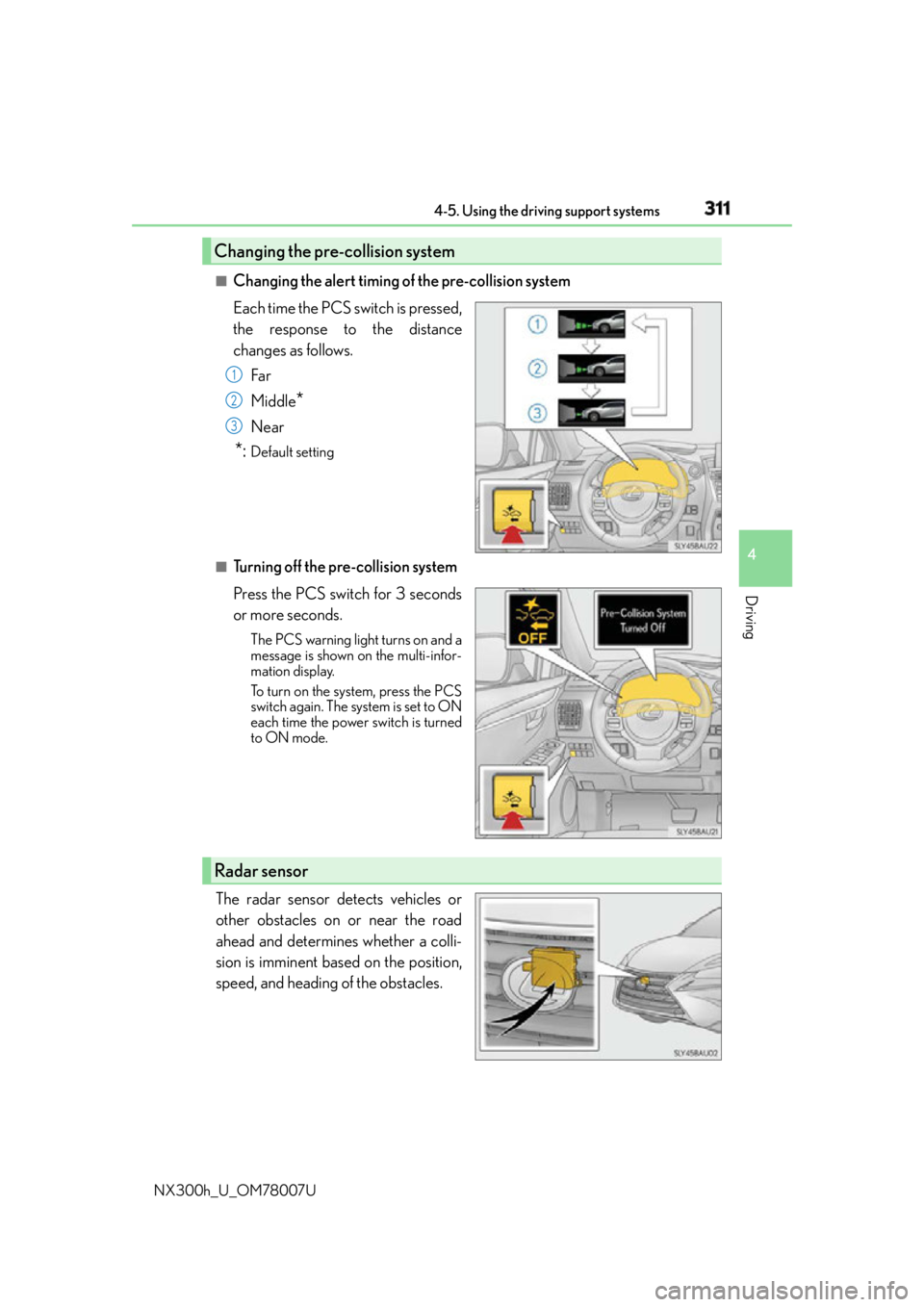
3114-5. Using the driving support systems
4
Driving
NX300h_U_OM78007U ■
Changing the alert timing of the pre-collision system
Each time the PCS switch is pressed,
the response to the distance
changes as follows.
Far
Middle
* Near
*: Default setting
■
Turning off the pre-collision system
Press the PCS switch for 3 seconds
or more seconds. The PCS warning light turns on and a
message is shown on the multi-infor-
mation display.
To turn on the system, press the PCS
switch again. The system is set to ON
each time the power switch is turned
to ON mode.
The radar sensor detects vehicles or
other obstacles on or near the road
ahead and determines whether a colli-
sion is imminent based on the position,
speed, and heading of the obstacles.Changing the pre-collision system 1
2
3
Radar sensor
Page 312 of 681
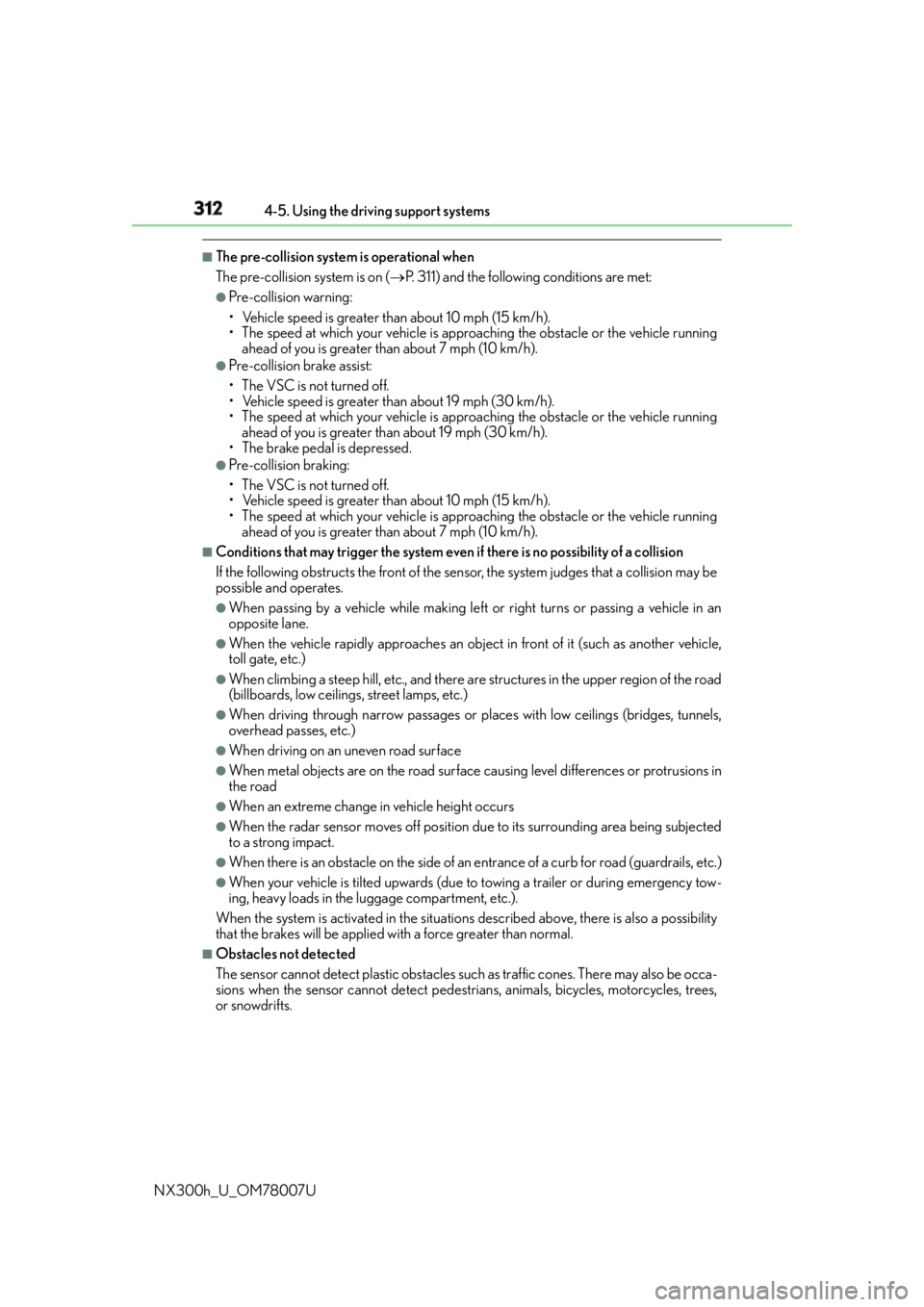
312 4-5. Using the driving support systems
NX300h_U_OM78007U ■
The pre-collision system is operational when
The pre-collision system is on ( P. 311) and the following conditions are met:●
Pre-collision warning:
• Vehicle speed is greater th an about 10 mph (15 km/h).
• The speed at which your vehicle is approaching the obstacle or the vehicle running
ahead of you is greater than about 7 mph (10 km/h). ●
Pre-collision brake assist:
• The VSC is not turned off.
• Vehicle speed is greater than about 19 mph (30 km/h).
• The speed at which your vehicle is approaching the obstacle or the vehicle running
ahead of you is greater than about 19 mph (30 km/h).
• The brake pedal is depressed. ●
Pre-collision braking:
• The VSC is not turned off.
• Vehicle speed is greater th an about 10 mph (15 km/h).
• The speed at which your vehicle is approaching the obstacle or the vehicle running
ahead of you is greater than about 7 mph (10 km/h).■
Conditions that may trigger the system even if there is no possibility of a collision
If the following obstructs the front of the sens or, the system judges that a collision may be
possible and operates. ●
When passing by a vehicle while making left or right turns or passing a vehicle in an
opposite lane. ●
When the vehicle rapidly approaches an object in front of it (such as another vehicle,
toll gate, etc.) ●
When climbing a steep hill, etc., and there are structures in the upper region of the road
(billboards, low ceilings , street lamps, etc.)●
When driving through narrow passages or places with low ceilings (bridges, tunnels,
overhead passes, etc.) ●
When driving on an uneven road surface ●
When metal objects are on the road surface causing level differences or protrusions in
the road ●
When an extreme change in vehicle height occurs ●
When the radar sensor moves off position du e to its surrounding area being subjected
to a strong impact. ●
When there is an obstacle on the side of an entrance of a curb for road (guardrails, etc.) ●
When your vehicle is tilted upwards (due to towing a trailer or during emergency tow-
ing, heavy loads in the lu ggage compartment, etc.).
When the system is activated in the situations described above, ther e is also a possibility
that the brakes will be applied wi th a force greater than normal.■
Obstacles not detected
The sensor cannot detect plasti c obstacles such as traffic co nes. There may also be occa-
sions when the sensor cannot detect pedestrians, animals, bicycles, motorcycles, trees,
or snowdrifts.
Page 313 of 681
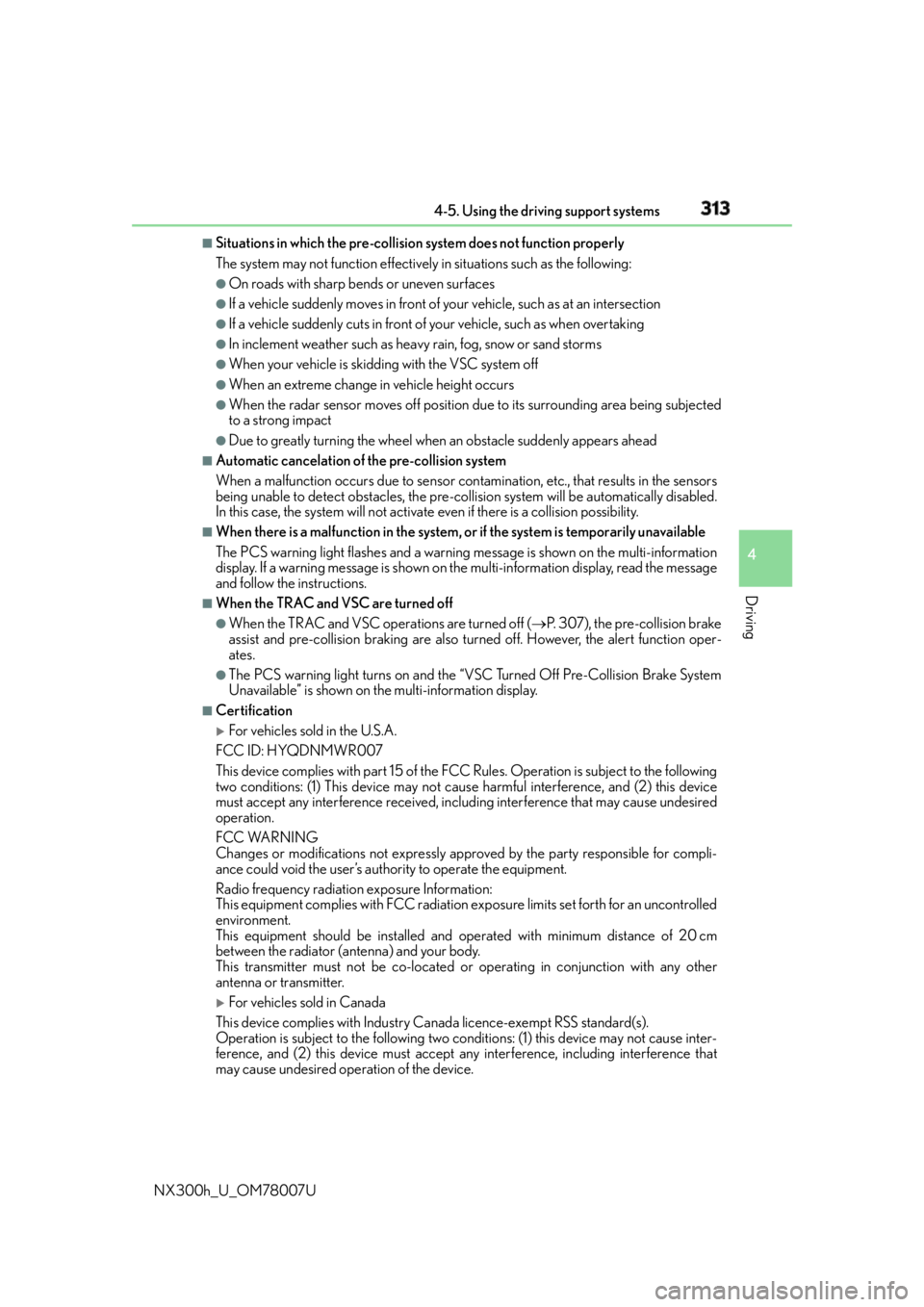
3134-5. Using the driving support systems
4
Driving
NX300h_U_OM78007U ■
Situations in which the pre-collision system does not function properly
The system may not function effectively in situations such as the following:●
On roads with sharp bends or uneven surfaces ●
If a vehicle suddenly moves in front of your vehicle, such as at an intersection ●
If a vehicle suddenly cuts in front of your vehicle, such as when overtaking ●
In inclement weather such as heav y rain, fog, snow or sand storms●
When your vehicle is skidding with the VSC system off ●
When an extreme change in vehicle height occurs ●
When the radar sensor moves off position du e to its surrounding area being subjected
to a strong impact ●
Due to greatly turning the wheel when an obstacle suddenly appears ahead ■
Automatic cancelation of the pre-collision system
When a malfunction occurs due to sensor contamination, etc., that results in the sensors
being unable to detect obstacles, the pre-collision syst em will be automatically disabled.
In this case, the system will not activate even if there is a collision possibility.■
When there is a malfunction in the system, or if the system is temporarily unavailable
The PCS warning light flashes and a warning message is shown on the multi-information
display. If a warning message is shown on th e multi-information display, read the message
and follow the instructions. ■
When the TRAC and VSC are turned off ●
When the TRAC and VSC operations are turned off ( P. 307), the pre-collision brake
assist and pre-collision braking are also turned off. However, the alert function oper-
ates. ●
The PCS warning light turns on and the “V SC Turned Off Pre-Collision Brake System
Unavailable” is shown on the multi-information display. ■
Certification
For vehicles sold in the U.S.A.
FCC ID: HYQDNMWR007
This device complies with part 15 of the FC C Rules. Operation is subject to the following
two conditions: (1) This device may not caus e harmful interference, and (2) this device
must accept any interference received, incl uding interference that may cause undesired
operation.
FCC WARNING
Changes or modifications not expressly approved by the party responsible for compli-
ance could void the user’s authority to operate the equipment.
Radio frequency radiation exposure Information:
This equipment complies with FCC radiation exposure limits set forth for an uncontrolled
environment.
This equipment should be installed and operated with minimum distance of 20 cm
between the radiator (antenna) and your body.
This transmitter must not be co-located or operating in conjunction with any other
antenna or transmitter.
For vehicles sold in Canada
This device complies with Industry Canada licence-exempt RSS standard(s).
Operation is subject to the following two co nditions: (1) this device may not cause inter-
ference, and (2) this device must accept any interference, including interference that
may cause undesired operation of the device.
Page 314 of 681
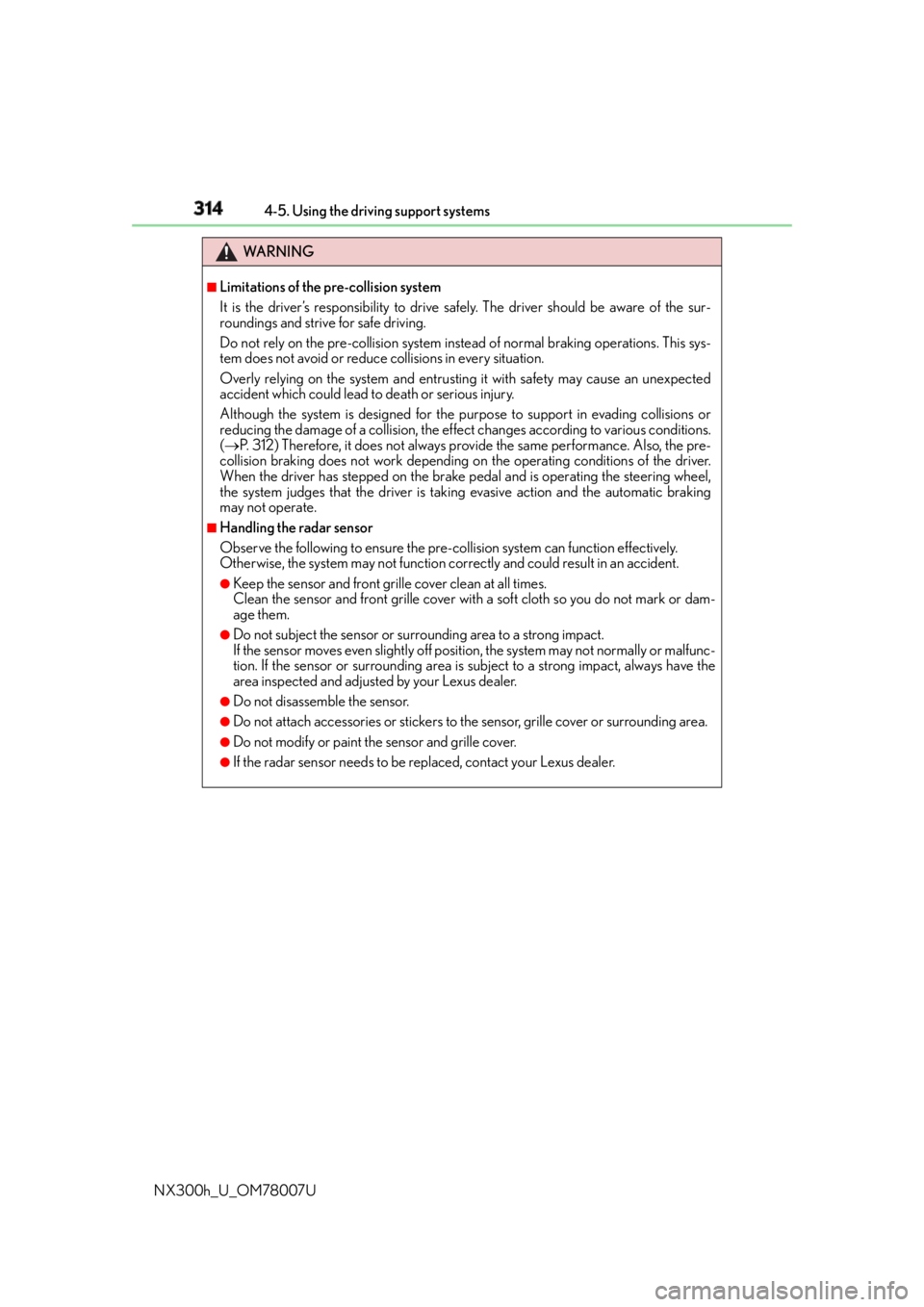
314 4-5. Using the driving support systems
NX300h_U_OM78007U WA R N I N G ■
Limitations of the pre-collision system
It is the driver’s responsibility to drive safely. The driver should be aware of the sur-
roundings and strive for safe driving.
Do not rely on the pre-collision system inst ead of normal braking operations. This sys-
tem does not avoid or reduce collisions in every situation.
Overly relying on the system and entrusting it with safety may cause an unexpected
accident which could lead to death or serious injury.
Although the system is designed for the pu rpose to support in evading collisions or
reducing the damage of a collision, the effect changes according to various conditions.
( P. 312) Therefore, it does not always provide the same performance. Also, the pre-
collision braking does not work depending on the operating conditions of the driver.
When the driver has stepped on the brake pedal and is operating the steering wheel,
the system judges that the driver is takin g evasive action and the automatic braking
may not operate. ■
Handling the radar sensor
Observe the following to ensure the pre-collision system can function effectively.
Otherwise, the system may not function correctly and could result in an accident. ●
Keep the sensor and front grille cover clean at all times.
Clean the sensor and front grille cover with a soft cloth so you do not mark or dam-
age them. ●
Do not subject the sensor or surr ounding area to a strong impact.
If the sensor moves even slightly off position, the system may not normally or malfunc-
tion. If the sensor or surrounding area is subject to a strong impact, always have the
area inspected and adjusted by your Lexus dealer. ●
Do not disassemble the sensor. ●
Do not attach accessories or stickers to the sensor, grille cover or surrounding area.●
Do not modify or paint the sensor and grille cover. ●
If the radar sensor needs to be re placed, contact your Lexus dealer.
Page 316 of 681
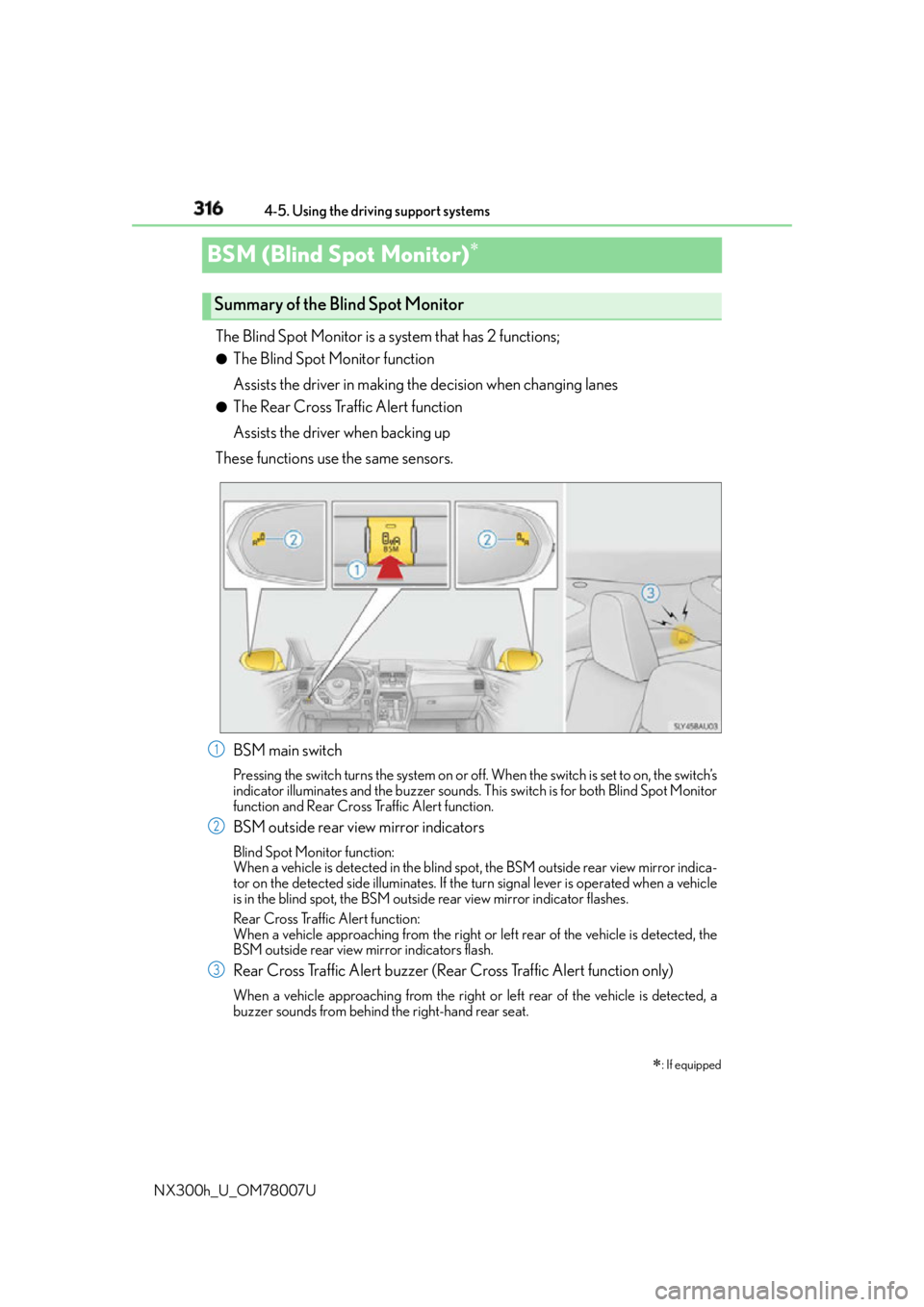
316 4-5. Using the driving support systems
NX300h_U_OM78007UBSM (Blind Spot Monitor) The Blind Spot Monitor is a system that has 2 functions; ●
The Blind Spot Monitor function
Assists the driver in making the decision when changing lanes ●
The Rear Cross Traffic Alert function
Assists the driver when backing up
These functions use the same sensors.
BSM main switch Pressing the switch turns the system on or of f. When the switch is set to on, the switch’s
indicator illuminates and the buzzer sounds. Th is switch is for both Blind Spot Monitor
function and Rear Cross Traffic Alert function.
BSM outside rear view mirror indicators Blind Spot Monitor function:
When a vehicle is detected in the blind spot , the BSM outside rear view mirror indica-
tor on the detected side illuminates. If the turn signal lever is operated when a vehicle
is in the blind spot, the BSM outside rear view mirror indicator flashes.
Rear Cross Traffic Alert function:
When a vehicle approaching from the right or left rear of the vehicle is detected, the
BSM outside rear view mirror indicators flash.
Rear Cross Traffic Alert buzzer (Rear Cross Traffic Alert function only) When a vehicle approaching from the right or left rear of the vehicle is detected, a
buzzer sounds from behind the right-hand rear seat.
: If equippedSummary of the Blind Spot Monitor
1
2
3
Page 317 of 681
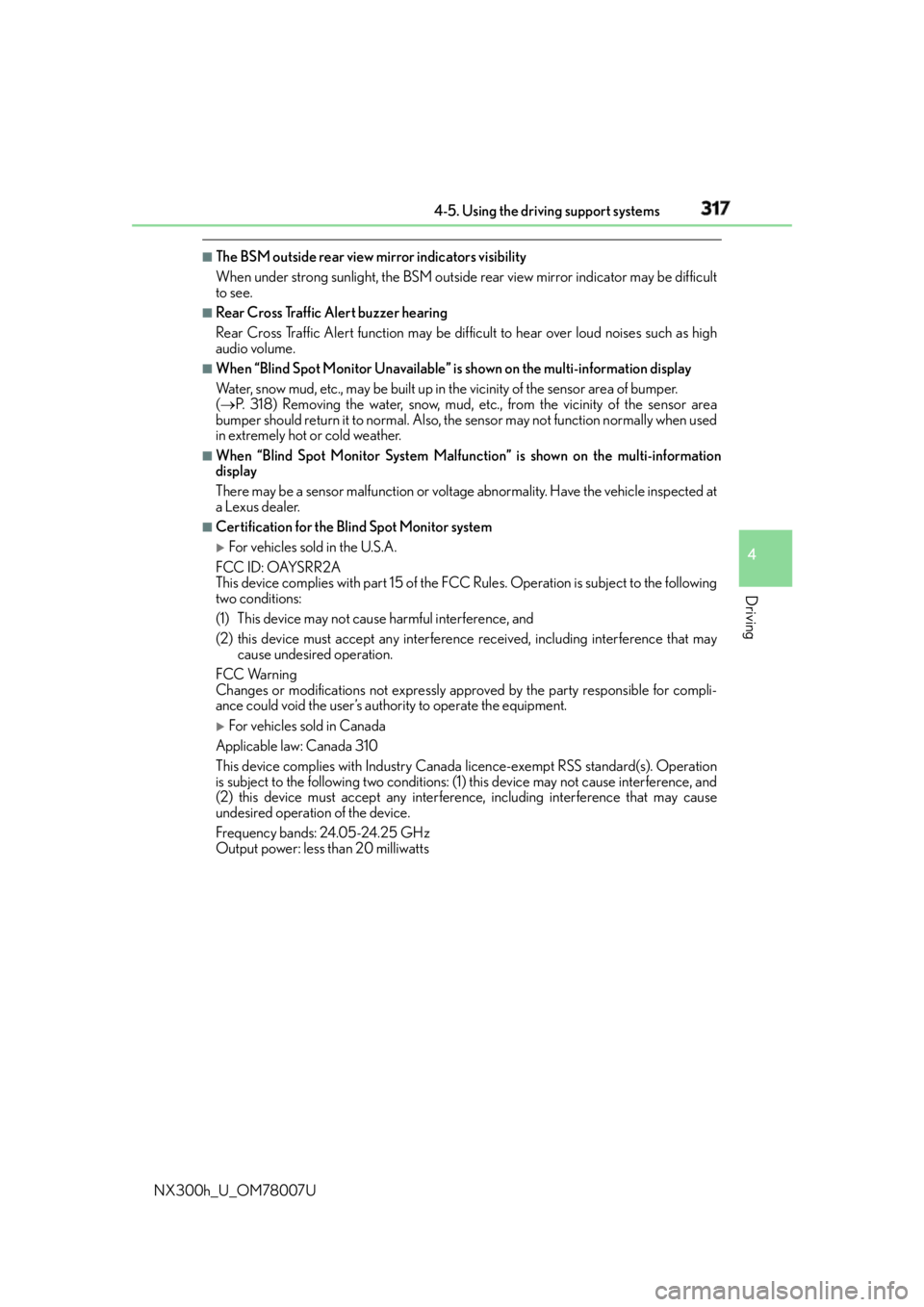
3174-5. Using the driving support systems
4
Driving
NX300h_U_OM78007U ■
The BSM outside rear view mirror indicators visibility
When under strong sunlight, the BSM outside rear view mirror indicator may be difficult
to see. ■
Rear Cross Traffic Alert buzzer hearing
Rear Cross Traffic Alert function may be difficult to hear over loud noises such as high
audio volume. ■
When “Blind Spot Monitor Unavailable” is shown on the multi-information display
Water, snow mud, etc., may be built up in the vicinity of the sensor area of bumper.
( P. 318) Removing the water, snow, mud, etc., from the vicinity of the sensor area
bumper should return it to normal. Also, the sensor may not function normally when used
in extremely hot or cold weather. ■
When “Blind Spot Monitor System Malfunct ion” is shown on the multi-information
display
There may be a sensor malfunction or voltag e abnormality. Have the vehicle inspected at
a Lexus dealer. ■
Certification for the Blind Spot Monitor system
For vehicles sold in the U.S.A.
FCC ID: OAYSRR2A
This device complies with part 15 of the FC C Rules. Operation is subject to the following
two conditions:
(1) This device may not cause harmful interference, and
(2) this device must accept any interference received, including interference that may
cause undesired operation.
FCC Warning
Changes or modifications not expressly approved by the party responsible for compli-
ance could void the user’s authority to operate the equipment.
For vehicles sold in Canada
Applicable law: Canada 310
This device complies with Industry Canada licence-exempt RSS st andard(s). Operation
is subject to the following two conditions: (1) this device may not cause interference, and
(2) this device must accept any interference, including interference that may cause
undesired operation of the device.
Frequency bands: 24.05-24.25 GHz
Output power: less than 20 milliwatts
Page 318 of 681
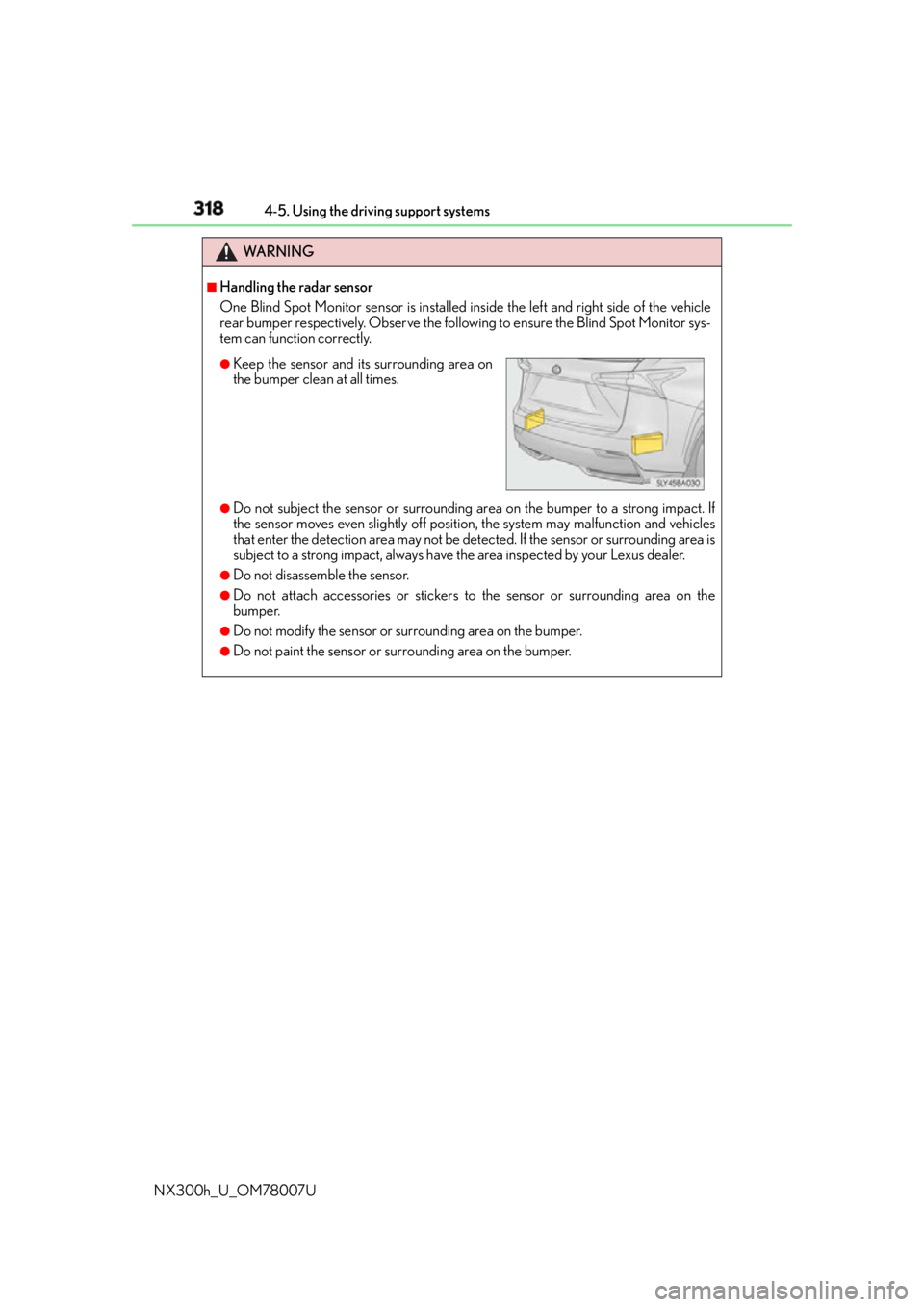
318 4-5. Using the driving support systems
NX300h_U_OM78007U WA R N I N G ■
Handling the radar sensor
One Blind Spot Monitor sensor is installed in side the left and right side of the vehicle
rear bumper respectively. Observe the following to ensure the Blind Spot Monitor sys-
tem can function correctly.
●
Do not subject the sensor or surrounding ar ea on the bumper to a strong impact. If
the sensor moves even slightly off position, the system may malfunction and vehicles
that enter the detection area may not be detected. If the sensor or surrounding area is
subject to a strong impact, always have the area inspected by your Lexus dealer. ●
Do not disassemble the sensor. ●
Do not attach accessories or stickers to the sensor or surrounding area on the
bumper. ●
Do not modify the sensor or su rrounding area on the bumper.●
Do not paint the sensor or surrounding area on the bumper. ●
Keep the sensor and its surrounding area on
the bumper clean at all times.
Page 319 of 681
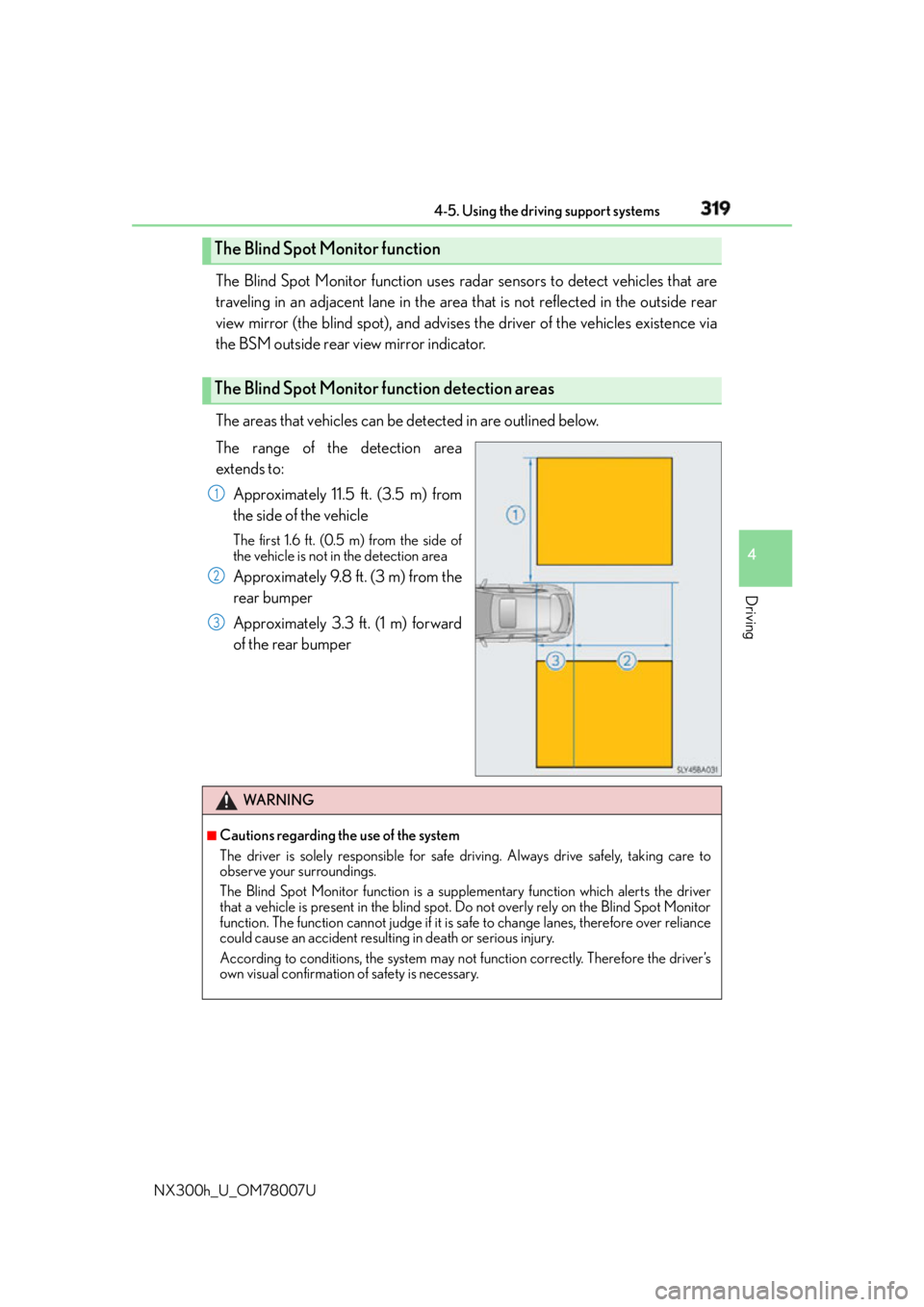
3194-5. Using the driving support systems
4
Driving
NX300h_U_OM78007U The Blind Spot Monitor function uses radar sensors to detect vehicles that are
traveling in an adjacent lane in the area that is not reflected in the outside rear
view mirror (the blind spot), and advises the driver of the vehicles existence via
the BSM outside rear view mirror indicator.
The areas that vehicles can be detected in are outlined below.
The range of the detection area
extends to:
Approximately 11.5 ft. (3.5 m) from
the side of the vehicle The first 1.6 ft. (0.5 m) from the side of
the vehicle is not in the detection area
Approximately 9.8 ft. (3 m) from the
rear bumper
Approximately 3.3 ft. (1 m) forward
of the rear bumperThe Blind Spot Monitor function
The Blind Spot Monitor function detection areas 1
2
3
WA R N I N G ■
Cautions regarding the use of the system
The driver is solely responsible for safe driving. Always drive safely, taking care to
observe your surroundings.
The Blind Spot Monitor function is a supp lementary function which alerts the driver
that a vehicle is present in the blind spot. Do not overly rely on the Blind Spot Monitor
function. The function cannot judg e if it is safe to change lanes, therefore over reliance
could cause an accident resulting in death or serious injury.
According to conditions, the system may not function correctly. Therefore the driver’s
own visual confirmation of safety is necessary.
Page 321 of 681

3214-5. Using the driving support systems
4
Driving
NX300h_U_OM78007U The Rear Cross Traffic Alert function operates when your vehicle is in reverse. It
can detect other vehicles approaching from the right or left rear of the vehicle. It
uses radar sensors to alert the driver of the other vehicle’s existence through
flashing the BSM outside rear view mirror indicators and sounding a buzzer.The Rear Cross Traffic Alert function
Approaching vehicles Detection areas1 2
WA R N I N G ■
Cautions regarding the use of the system
The driver is solely responsible for safe driving. Always drive safely, taking care to
observe your surroundings.
The Rear Cross Traffic Alert function is only an assist and is not a replacement for care-
ful driving. Driver must be careful when ba cking up, even when us ing Rear Cross Traffic
Alert function. The driver’s own visual confirmation of behind you and your vehicle is
necessary and be sure there are no pedestrians, other vehicles, etc., before backing up.
Failure to do so could cause death or serious injury.
According to conditions, the system may not function correctly. Therefore the driver’s
own visual confirmation of safety is necessary.